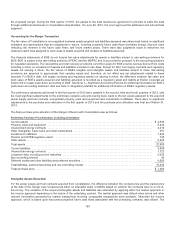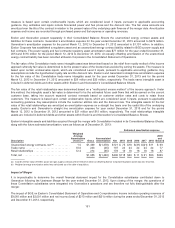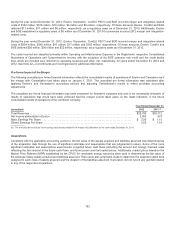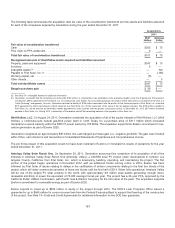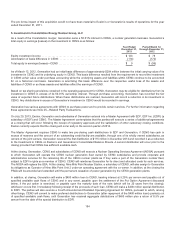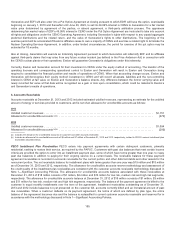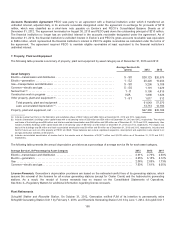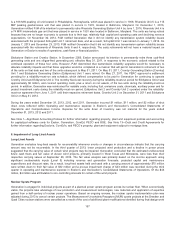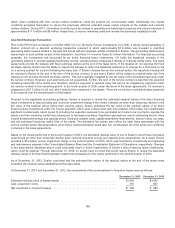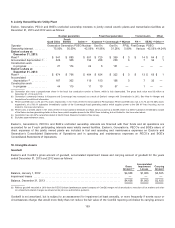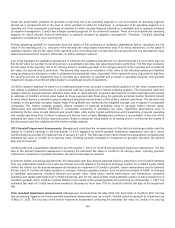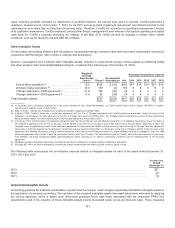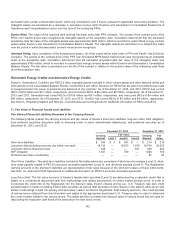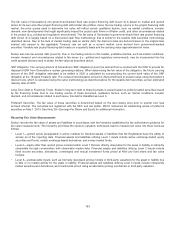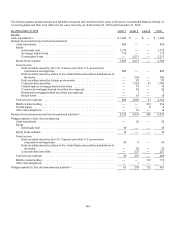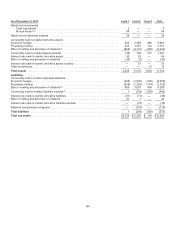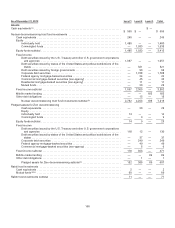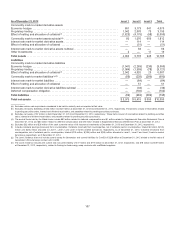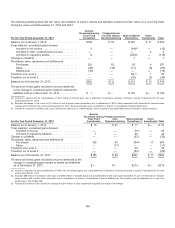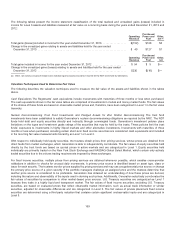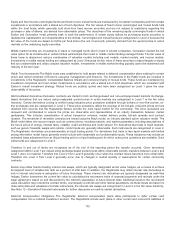ComEd 2013 Annual Report Download - page 166
Download and view the complete annual report
Please find page 166 of the 2013 ComEd annual report below. You can navigate through the pages in the report by either clicking on the pages listed below, or by using the keyword search tool below to find specific information within the annual report.Under the authoritativeguidancefor goodwill,a reportingunitis an operatingsegment or one level belowan operatingsegment
(knownasacomponent)andisthelevel at which goodwill is testedfor impairment.Acomponent ofan operatingsegment is a
reportingunitif thecomponent constitutesabusiness for which discrete financial information is available andisregularlyreviewed
by segment management.ComEd hasasingle operatingsegment for itscombinedbusiness. There is no level belowthis operating
segment for which discrete financial information is regularlyreviewedbysegment management.Therefore,ComEd’s operating
segment is considereditsonlyreportingunit.
Entitiesassessinggoodwill for impairment havethe option offirst performingaqualitativeassessment before calculatingthefair
value ofthe reportingunit(i.e., step one ofthetwo-step fairvalue basedimpairment test). If an entitydetermines, on thebasis of
qualitativefactors, that thefairvalue ofthe reportingunitis more likelythan not less than thecarryingamount,thetwo-step fairvalue
basedimpairment testis required. Otherwise,no further testingisrequired.
If an entitybypassesthequalitativeassessment or performs thequalitativeassessment,but determinesthat itis more likelythan not
that itsfairvalue is less than itscarryingamount,aquantitativetwo-step,fairvalue basedtestis performed. Thefirststep compares
thefairvalue ofthe reportingunittoitscarryingamount,includinggoodwill.Ifthecarryingamount ofthe reportingunitexceeds its
fairvalue,thesecondstep is performed. Thesecondstep requiresan allocation offairvalue to theindividual assetsandliabilities
usingpurchaseprice allocation inorder to determine theimpliedfairvalue ofgoodwill.Iftheimpliedfairvalue ofgoodwill is less than
thecarryingamount,an impairment loss is recordedasareduction to goodwill andacharge to operatingexpense.Anygoodwill
impairment chargeatComEd will affectExelon’s consolidatedresultsofoperations.
ComEd’s valuation approach is basedon a market participant view, pursuant to authoritativeguidancefor fairvalue measurement,
andutilizesaweightedcombination ofadiscountedcash flowanalysis andamarket multiplesanalysis. Thediscountedcash flow
analysis relieson a single scenarioreflecting“basecase”or “bestestimate”projectedcash flows for ComEd’s business andincludes
an estimate ofComEd’s terminal value basedon theseexpectedcash flows usingthegenerallyacceptedGordon DividendGrowth
formula, which derivesavaluation usingan assumedperpetual annuitybasedon the entity’s residual cash flows. Thediscount rate
is basedon thegenerallyacceptedCapital Asset PricingModel andrepresentstheweightedaveragecostofcapital ofcomparable
companies. Themarket multiplesanalysis utilizesmultiplesofbusiness enterprisevalue to earnings, before interest,taxes,
depreciation andamortization (EBITDA)ofcomparable companiesinestimatingfairvalue. Significant assumptionsusedin
estimatingthefairvalue includediscount andgrowthrates, utilitysector market performanceandtransactions, projectedoperating
andcapital cash flows fromComEd’s business andthefairvalue ofdebt.Management performs areconciliation ofthesumofthe
estimatedfairvalue ofall Exelon reportingunitsto Exelon’s enterprisevalue basedon itstradingpricetocorroborate theresultsof
thediscountedcash flowanalysis andthemarket multiple analysis.
2013 Goodwill Impairment Assessments. Management concludedtheremeasurement ofthelike-kindexchangeposition andthe
chargetoComEd’s earnings inthefirstquarter of2013 triggeredan interim goodwill impairment assessment and, asaresult,
ComEd testeditsgoodwill for impairment asofJanuary31,2013.Thefirststep oftheinterim impairment assessment comparingthe
estimatedfairvalue ofComEd to itscarryingvalue,includinggoodwill,indicatedno impairment ofgoodwill;therefore,thesecond
step wasnot required.
ComEd performedaquantitativeassessment asofNovember 1,2013,for its2013 annual goodwill impairment assessment.Thefirst
step ofthe annual impairment assessment comparingtheestimatedfairvalue ofComEd to itscarryingvalue,includinggoodwill,
indicatedno impairment ofgoodwill;therefore,thesecondstep wasnot required.
Inboththeinterim andannual assessments, thediscountedcash flowanalysis reflectedExelon’s indemnityto holdComEd harmless
fromanyunfavorable impactsoftheafter-taxinterestamountsrelatedto thelike-kindexchangeposition on ComEd’s equity. While
neither theinterim nor the annual assessmentsindicatedan impairment ofComEd’s goodwill,certainassumptionsusedto estimate
thefairvalue ofComEd are highlysensitivetochanges. Adverseregulatoryactions, such asearlytermination of EIMA,or changes
insignificant assumptions, including discount andgrowthrates, utilitysector market performanceandtransactions, projected
operatingandcapital cash flows fromComEd’s business, andthefairvalue ofdebtcouldpotentiallyresult inafuture impairment of
ComEd’s goodwill, which couldbematerial.Basedon theresultsofthe annual goodwill test performedasofNovember 1,2013,the
estimatedfairvalue ofComEd wouldhave neededto decreaseby more than 10%for ComEd to failthefirststep oftheimpairment
test.
Prior Goodwill Impairment Assessments. Management concludedthat theMay2012 ICC final Order inComEd’s 2011 formula
rate proceedingtriggeredan interim goodwill impairment assessment and, asaresult,ComEd testeditsgoodwill for impairment as
ofMay31,2012.Thefirststep oftheinterim impairment assessment comparingtheestimatedfairvalue ofComEd to itscarrying
160


